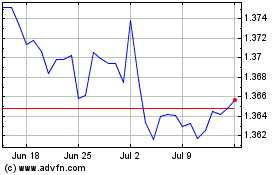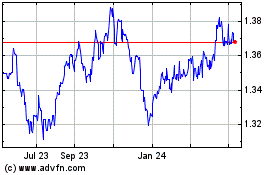Dollar Extends Decline Following Trump's Warning On Strong Currency
January 17 2017 - 2:23AM
RTTF2
The U.S. dollar extended decline against its major counterparts
in the European session on Tuesday, in response to the U.S.
President-elect Donald Trump's warning over the elevated domestic
currency that would dampen U.S. competitiveness.
In his interview with the Wall Street Journal on Friday, Trump
said that the dollar value is "too strong" partly due to China
holding down its currency, the yuan.
"Our companies can't compete with them now because our currency
is too strong. And it's killing us," he added.
Trump's remarks were reiterated by his senior adviser, Anthony
Scaramucci of Skybridge Capital, who cautioned today that the
rising dollar could be the "biggest challenge" for the economic
outlook over the coming year.
The comments added to anxiety over the increasingly
protectionist stance of the incoming Trump administration and
uncertainty regarding the economic policies when he assumes charge
this Friday.
Risk-off mood prevailed, as investors focused on the U.K. Prime
Minister Theresa May's speech, which is expected to outline a
"hard" exit from the European Union.
Investors became wary over reports that the U.K. PM is likely to
prefer a clean break from the EU, quitting from its single market
for goods and services and forge a completely new trading
relationship with the bloc.
The currency has been trading in a negative territory in the
previous session.
The greenback declined to 112.73 against the Japanese yen, its
lowest since November 30, 2016. The next possible support for the
greenback-yen pair is seen around the 110.00 mark.
Final figures from the Ministry of Economy, Trade and Industry
showed that Japan's industrial production increased as initially
estimated in November.
Industrial production rose a seasonally adjusted 1.5 percent
month-over-month in November, after remaining flat in the previous
month. That was in line with the flash data published on December
27.
The greenback slid to a 2-month low of 0.9997 against the franc,
while falling to 1.0719 against the euro, its weakest since
December 8. Continuation of the greenback's downtrend may see it
challenging support around 0.98 versus the franc and 1.085 versus
the euro.
The greenback dropped to a new 2-month low of 0.7562 against the
aussie, near 5-week low of 0.7198 against the kiwi and near a
3-month low of 1.3019 versus the loonie, off its early highs of
0.7465 and 0.7096, and a 6-day high of 1.3190, respectively. If the
greenback extends slide, it may locate support around 0.765 against
the aussie, 0.73 against the kiwi and 1.29 against the loonie.
The greenback weakened to a 5-day low of 1.2277 against the
pound, after having advanced to 1.2017 in the beginning of the
Asian session. The greenback is poised to locate support around the
1.26 region.
Data from the Office for National Statistics showed that U.K.
inflation reached its highest level since July 2014.
Consumer price inflation increased more-than-expected to 1.6
percent in December from 1.2 percent in November. This was the
highest rate since July 2014 and above the expected rate of 1.4
percent.
U.S. Empire State manufacturing index for January is slated for
release in the New York session.
At 8:45 am ET, Federal Reserve Bank of New York President
William Dudley is expected to speak about consumer behavior at the
National Retail Federation Convention and Expo, in New York.
At 10:00 am ET, Federal Reserve Board Governor Lael Brainard is
expected to speak on monetary and fiscal policy before the
Brookings Institution, in Washington, U.S.
Subsequently, Federal Reserve Bank of San Francisco President
John Williams is expected to speak before the Sacramento Business
Review Economic Forecast event, in Sacramento, U.S.
US Dollar vs CAD (FX:USDCAD)
Forex Chart
From Mar 2024 to Apr 2024

US Dollar vs CAD (FX:USDCAD)
Forex Chart
From Apr 2023 to Apr 2024
